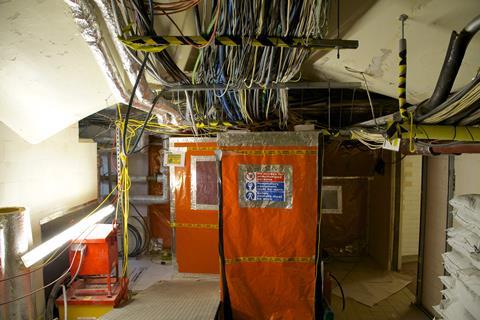New information provided by body overseeing £50bn scheme suggests option more straightforward than current plan
Gutting the interior of the Palace of Westminster and rebuilding it from the inside would be a more straightforward approach to restoring the grade I-listed building, new information provided by the body overseeing the project has revealed.
Internal works on the refurbishment of Parliament are significantly complicated by the building’s layout, narrow corridors and its heritage value, according to the Parliamentary Works Sponsor Body.
Details on the scheme provided by the body suggested that an easier approach would be to entirely remove the interior and rebuild it from scratch, but that this would be “impossible under modern heritage and conservation principles”.

A report published by the body last month revealed that the restoration of Parliament might not be finished until the end of this century and be well over double the cost of Crossrail if MPs and staff do not vacate the building while the works are carried out.
The most detailed study yet found that keeping the Commons and the Lords in situ during the refurbishment could take up to 76 years and cost nearly £50bn, which includes VAT and inflation.
The cheapest option, which would require the building to be vacated for up to two decades, would still cost at least £7bn and had an 80% chance of costing £13bn, the report said.
The works will require all of the palace’s antiquated systems, including heating, plumbing and data cables, to be replaced and a significant volume of new plant space installed while preserving the existing fabric of the 150-year-old building.
This would involve removing, documenting and storing parts of the structure’s fabric before works can begin and reinstating them once new building services have been installed.
It is understood that the need to remove a vast quantity of asbestos, and the health and safety risks involved, are a significant factor in the estimated duration of the project.
The sponsor body also indicated that restricted access routes into the building, and its constrained site next to the river Thames, severely limit the amount of work that can be carried out on the building at any one time.
Both the Lords and the Commons agreed in principle to the restoration works on the Palace of Westminster in 2018 on the basis that they would cost around £4bn and see occupants ‘decant’ to temporary facilities for six years.
But the rising costs of the project have triggered a debate in parliament over the best approach, with several MPs, including Commons leader Mark Spencer, arguing that MPs, peers and staff should stay in the building while the works are carried out.
The House of Commons Commission has voted for the sponsor body to be scrapped and for the programme to report to MPs instead. It is understood that this move, which requires a vote in the Commons to be confirmed, will result in new proposals for the restoration being developed under revised objectives.



























No comments yet